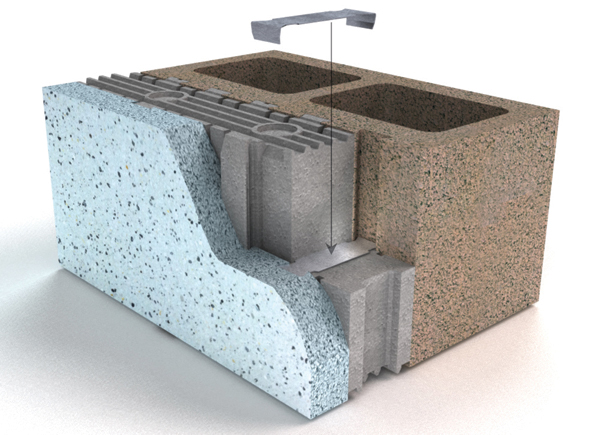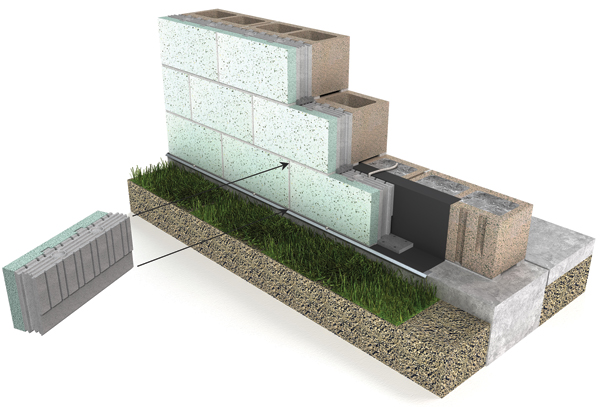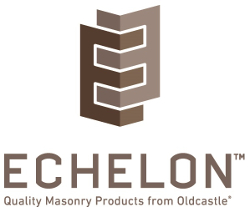Insulation Gets More Effective
Compared to other polystyrene-based rigid foams and to polyisocyanurate rigid foam, this substance maintains more of its R-value when temperatures drop. As the temperatures decrease, the high-purity graphite integrated into the polymer matrix of the substance contributes more to slowing the flow of heat through the material. This type of foam is GreenGuard certified for Indoor Air Quality and is produced without fluorocarbons (CFC, HFC, HCFC) as an expansion agent, materials that can be harmful to the environment and have a negative effect on a structure's carbon footprint. Instead, an alternate substance known as pentane, a hydrocarbon of the methane series, is used during the manufacturing process as an expansion agent, with no ozone depletion potential and low global warming potential. It can be reclaimed for use in energy production for the manufacturing process.
This type of insulation provides the designer with flexibility as it is adaptable in size, shape and density, which eliminates the need to glue together multiple boards to achieve the desired insulation thickness—a characteristic that enables designers to achieve R-value targets in a thickness-constrained application. Monolithic 'boards' can be produced in thicknesses up to 48 inches and can be shape molded with corners and interlocking features. As codes evolve and R-value targets become ever more stringent, ICMS perhaps offer the best chance of easily adapting as a slight increase in insulation thickness can provide the necessary thermal performance. Many color and texture options are available. The thin face veneers are pre-assembled with the insulation insert and structural block, and architects can specify specific veneers to meet the desired aesthetic goals. Interior and exterior appearances can vary with, say, the inside wall being a gray tone and the exterior wall brown, or any other variation in color.

Image courtesy of Oldcastle® Architectural
The thin face veneers are pre-assembled with the insulation insert and structural block, and architects can specify specific veneers to meet the desired aesthetic goals.
ICMS with stainless steel ties offer protection in various extreme situations. Because it does not readily corrode, rust or stain with water as does ordinary steel, stainless steel anchors can be effective in salt water or coastal environments. In the event of a fire, the wall system's integrity is preserved by stainless steel ties that secure the thin veneer to the structural block. The latest EPS technologies incorporate fire retarders so that the ICMS does not contribute to flame spread. The stainless steel ties further provide wind-load resistance and protection against wind shear.

Image courtesy of Oldcastle® Architectural
In the event of a fire, the wall system’s integrity is preserved by stainless steel ties that secure the thin veneer to the structural block.
In terms of moisture management, some closed cell foams have a Class III Vapor Permeability rating of between 2.5 and 5.5 perms depending on thickness and density, meaning that this type of continuous insulation can more easily transport water vapor, reducing the likelihood of mold, mildew and structural damage. Architects should investigate the water absorption rate of the material relative to traditional insulation materials.
One critical area where ICMS have an advantage over other systems is installation. Proper installation is vital to the effective functioning of any wall assembly, and installing wall assemblies with numerous elements can be time-consuming, costly, and prone to error. As a single pass system, the ICMS affords simplified installation, eliminating the need for adding insulation and finishing materials, saving associated labor costs and improving accuracy.

Image courtesy of Oldcastle® Architectural
Flashing detail of insulated concrete block masonry system
Insulation Gets More Effective
It goes without saying that energy codes and green building programs will continue their evolution prescribing ever stricter and more complete energy targets. R-values will increase, as will the demands of insulation within the wall system. Architects are in a position to further green building goals through the specification of effective insulation systems that decrease thermal loss and enable the building envelope to retard moisture intrusion and withstand fire and extreme wind conditions, while permitting a full range of aesthetic options and ease of installation. New all-in-one, or single pass systems, help meet all these goals, and represent a valuable addition to the designer's toolbox.

|
Echelon is the consolidated brand for all masonry products and services of Oldcastle Architectural including Trenwyth® Architectural Masonry, Artisan Masonry Stone Veneers®, Quik-Brik® Concrete Masonry Units, Amerimix® Bagged Goods and a complete portfolio of Performance Upgrades. As a single source masonry portfolio solution, Echelon delivers consistent, reliable product manufactured locally at more than 170 locations and delivered by an unrivaled logistics network. For more information, call (844) 495-8211 or visit EchelonMasonry.com |








